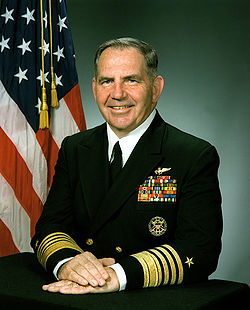Analysis in Combat — Desert Storm
Over the five months of Desert Shield and Desert Storm, 40 CNA field representatives supported and analyzed operations. Of those, 22 deployed with their commands to the Middle East, serving on Navy ships, Marine Corps forward bases, and Joint command centers. And after Kuwait had been liberated, these analysts returned to CNA headquarters to assemble the definitive, 18-volume reconstruction and account of lessons learned by the Navy and Marine Corps in the Gulf War.
Adm. Stanley R. Arthur,
Commander of Naval Forces in Desert Storm
(from Desert Storm at Sea)
DESERT STORM STORIES
The Plan in My Pocket
By Dr. Katherine McGrady
Katherine McGrady, the CEO of CNA, recalls her first wartime analyses, and the plan the officers never thought they would need — until they did.
Risky Business
By Dr. Bob Ward
Flying to a carrier was familiar territory for an experienced CNA field representative like Dr. Bob Ward. But getting to USS Kennedy in the Red Sea just days before Desert Storm was hectic.”
CNA Talks: Analysis in Combat
In recognition of the 30th anniversary of Desert Storm, CNA Talks presents Analysis in Combat. In this mini-series we’ll be bringing you interviews with CNA field representatives, military officers and historians about the conflict and the impact of CNA's Field Program on the war effort.
This mini-series presents interviews with CNA analysts who were supporting forces in theater during Desert Storm.




CNA CASE STUDIES
CALCULATING UNSEEN DANGERS
CNA analysts in the race against Persian Gulf mines
The most dangerous weapon threatening the U.S. fleet in Desert Storm turned out to be underwater mines. CNA analysts supporting naval forces calculated the risk to protect the mission — and save lives.
FLOATING WAREHOUSES AND FLYING MARINES
CNA and Maritime Prepositioning satisfy the need for speed
When the Marine Corps needed to send an entire expeditionary brigade to the Persian Gulf in less than two weeks, it depended upon the Maritime Prepositioning Force. CNA analysts had helped develop this novel force from a blank sheet of paper to tanks on the ground.